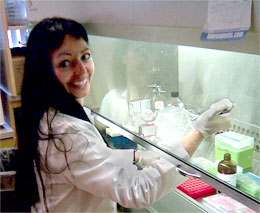Anti-inflammatory Drugs May Defeat a Treatment-Resistant Type of Cancer
JUNE 24, 2009
By Kim McDonald

Irene Pedersen’s translational research has revealed a potential new treatment for a form of lymphoma.
Credit: Photo courtesy Irene Pedersen.
Effective drugs for treating a chemotherapy-resistant form of lymphoma might already be on the market according to a study that has pieced together a chemical pathway involved in the disease.
By following the trail of several molecular flags that mark this type of cancer, a team from the University of California, San Diego, the Burnham Institute for Medical Research and the Copenhagen University Hospital have discovered that anti-inflammatory drugs used to treat arthritis also shrink lymphoma tumors in mice.
Their report, published in the July issue of the journal EMBO Molecular Medicine, also strengthens evidence for a link between inflammation and cancer.
“If this shows promise with early clinical experiments, the treatment would be immediately available,” said Michael David, a professor of biology who leads the group at UC San Diego.
The study focused on a type of non-Hodgkin lymphoma called diffuse large B-cell lymphoma (DLBCL). In one form of the disease, chemotherapy works well, and according to one recent study more than 75 percent of patients survive five years or longer. But that study also described a variant of this cancer that proved difficult to treat. Those patients failed to respond to conventional chemotherapy, and only 16 percent were reported to survive more than five years after they were diagnosed.
Irene Pedersen, a research scientist at UC San Diego and lead author of the paper, isolated cells from biopsies of patients suffering from the poor-prognosis form of DLBCL, and found depressed levels of SHIP1, a protein whose tumor suppressive function was recently identified by their Burnham collaborators. Additional bioinformatic analysis of a scientific database revealed that patients with the lowest levels of SHIP1 are indeed the least likely to survive.
Pedersen demonstrated that the inhibition of SHIP1 expression in these treatment-resistant lymphoma cells is the result of elevated levels of miR-155, a specific example of a type of genetic material called microRNA. miR-155 suppresses SHIP1 by sticking to the template for the protein, preventing its manufacture.
The final clue came from earlier reports that an inflammatory molecule called TNFα could raise the amount of miR-155 in macrophages. Additional laboratory work confirmed that this also holds true for lymphoma cell.
This raised the possibility that patients might respond favorably to a treatment that interrupted this inflammatory response pathway, and so “…it made sense to try to block TNFα,” David said. Anti-inflammatory drugs eternacept and infliximab, which are currently used to treat arthritis and inflammatory bowel disease, work by suppressing TNFα. The UCSD researchers tested their idea in mice that had been injected with aggressive lymphoma cells and found that the resulting tumors shrank significantly within six days.
“The prevailing thought is that you need two mutations to get cancer, but it might take just one mutation plus inflammation,” the team explained, “Our findings strengthen the scientific link between inflammation and tumor progression, and suggest a new way to curb the malignancy of this type of lymphoma.”
The investigators are currently initiating a pilot study in Copenhagen to evaluate this potential new treatment in patients with diffuse large B-cell lymphoma who have not responded to conventional chemotherapy.
Researchers that contributed to this study included members of the David lab - Dennis Otero and Elaine Kao - in collaboration with Ana Miletic from the laboratory of Robert Rickert (Burnham Institute), and Christopher Hother, Elisabeth Ralfkiaer and Kirsten Groenbaek at the Copenhagen University Hospital. The research was funded by the National Cancer Institute and the Danish Novo Foundation
Media Contact:- Susan Brown, sdbrown@ucsd.edu, (858) 246-0161
- Irene Pedersen, 858-822-1107 or ipedersen@ucsd.edu
- Michael David, 858-822-1108 or midavid@ucsd.edu
